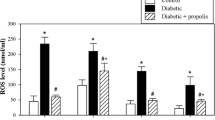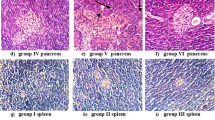Abstract
Diabetic patients present an increased susceptibility to frequent and protracted infections. The recognition of an impaired immune system has implications for the diagnosis, treatment and outcome of infections. Nuclear Factor kappa B (NF-κB) is a redox sensitive transcription factor involved in immune response, cell proliferation and apoptosis that has been associated to the development of diabetic complications. Herein we study the effects of high glucose on oxidative stress markers (malondialdeyde and glutathione contents) and NF-κB activity in U937 cells (a human promonocytic cell line). Furtheremore effects of lutein treatment in lymphocytes from diabetic rats was studied. The results show that high glucose induces oxidative stress in immune system cells, both in vitro and in vivo, as well as an increase in their NF-κB activity. It is also showed that lutein, a natural antioxidant without hypoglycemiant properties, is able to prevent all the alterations observed. Thus, this study confirms the role of oxidative stress in the immune system impairment described in diabetes, and allows the proposal of antioxidants for the clinical management of the diabetes-associated susceptibility to infections.
Resumen
Los pacientes diabéticos presentan mayor susceptibilidad a sufrir infecciones prolongadas y frecuentes. El reconocimiento de alteraciones del sistema inmune es importante para el diagnóstico, tratamiento y evolución de las infecciones. El factor nuclear ϰB es un factor de transcripción sensible al estado redox de la célula e implicado en la respuesta inmune, proliferación celular y apoptosis, que ha sido asociado con el desarrollo de las complicaciones de la diabetes. En este trabajo, se estudia el efecto de niveles elevados de glucosa sobre parámetros indicadores de estrés oxidativo y sobre la actividad del NF-ϰB, tanto en células U937 cultivadas con altas concentraciones de glucosa como en linfocitos aislados de ratas diabéticas. Igualmente, se ensaya un tratamiento con el antioxidante luteína. Los resultados muestran que altos niveles de glucosa inducen estrés oxidativo en células del sistema inmune, tanto in vitro como in vivo, y aumentan la actividad del NF-ϰB. También se muestra que la luteína, un antioxidante sin propiedades hipoglucemiantes, es capaz de prevenir dichas alteraciones. Por lo tanto, este estudio confirma la implicación del estrés oxidativo en las alteraciones de las células inmunes descritas en la diabetes, y permite proponer a los antioxidantes como tratamiento clínico coadyuvante en la prevención de las infecciones asociadas a la diabetes.
Similar content being viewed by others
References
Barzilay, J.I., Abraham, L., Heckbert, S.R., Cushman, M., Kuller, L.H., Resnick, H.E. and Tracy, R.P. (2001): The relation of markers of inflammation to the development of glucose disorders in the elderly: the Cardiovascular Health Study. Diabetes, 50, 2384–2389.
Baynes, J.W. and Thorpe, S.R. (1999): Role of oxidative stress in diabetic complications: a new perspective on an old paradigm. Diabetes, 48, 1–9.
Brownlee, M., Cerami, A. and Vlassara, H. (1988): Advanced glycosylation end products in tissue and the biochemical basis of diabetes complications. N Engl J Med, 318, 1315–1321.
Bunting, K., Rao, S., Hardy, K., Waltring, D., Denyer, G.S., Wang, J., Gerondakis, S. and Shannon, M.F. (2007): Genome-wide analysis of gene expression in T cells to identify targets of the NF-kappaB transcrition factor c-Rel. J Immunol, 178, 7097–7109.
Carlsen, H., Moskaug, J.O., Fromm, S.H. and Blomhoff, R. (2002): In vivo imaging of NF-kappaB activity. J Immunol, 168, 1441–1446.
Chew, B.P., Brown, C.M., Park, J.S. and Mixter, P.F. (2003): Dietary lutein inhibits mouse mammary tumor growth by regulating angiogenesis and apoptosis. Anticancer Res, 23, 3333–3339.
Dandona, P., Aljada, A. and Mohanty, P. (2002): The anti-inflammatory and potential anti-atherogenic effect of insulin: a new paradigm. Diabetologia, 45, 924–930.
Guha, M., Bai, W., Nadler, J.L. and Natarajan, R. (2000): Molecular mechanisms of tumor necrosis factor α gene expression in monocytic cells via hyperglycemia-induced oxidant stress-dependent and-independent pathways. J Biol Chem, 275, 17728–17739.
Halliwell, B. (2000): Oxidative stress markers in human disease: application to diabetes and to evaluation of the effects of antioxidants. In “Antioxidants in Diabetes Management”, (Packer L, Rösen P, Tritschler HJ, King GL & Azzi A, eds.), Marcel Dekker, New York, pp. 33–52.
Hofmann, M.A., Schiekofer, S., Kanitz, M., Klevesath, M.S., Joswig, M., Lee, W., Morcos, M., Tritschler, H., Ziegler, D., Wahl, P., Bierhaus, A. and Nawroth, P.P. (1998): Insufficient glycemic control increases nuclear factor-kappa B binding activity in peripheral blood mononuclear cells isolated from patients with type 1 diabetes. Diabetes Care, 21, 1310–1316.
Hotta, N. (1995): New approaches for treatment of diabetes: aldose reductase inhibitors. Biomed Pharmacother, 49, 232–243.
Ido, Y., Kilo, C. and Williamson, J.R. (1997): Cytosolic NADH/NAD+, free radicals, and vascular dysfunction in early diabetes mellitus. Diabetologia, 40 (suppl. 2), S115-S117.
Ishii, H., Daisuke, K. and King, G.L. (1998): Protein kinase C activation and its role in the development of vascular complications in diabetes mellitus. J Mol Med, 76, 21–31.
Joshi, N., Caputo, G.M., Weitekamp, M.R. and Karchmer, A.W. (1999): Infections in patients with diabetes mellitus. New Engl J Med, 341, 1906–1912.
Kashiwagi, A., Asahina, T., Nishio, Y., Ikebuchi, M., Tanaka, Y., Kikkawa, R. and Shigeta, Y. (1996): Glycation, oxidative stress and scavenger activity: glucose metabolism and radical scavenger dysfunction in endothelial cells. Diabetes, 45 (suppl. 3), S84-S86.
Katz, S., Klein, B., Elian, I., Fishman, P. and Djaldetti, M. (1983): Phagocytotic activity of monocytes from diabetic patients. Diabetes Care, 83, 479–482.
Kim, H.B., Chew, B.P., Wong, T.S., Park, J.S., Weng, B.B., Byrne, K.M., Hayek, M.G. and Reinhardt, G.A. (2000): Dietary lutein stimulates immune response in the canine. Vet Immunol Immunopathol, 74, 315–327.
Li, N. and Karin, M. (1999): Is NF-kappaB the sensor of oxidative stress? FASEB J, 13, 1137–1143.
Miranda, M., Muriach, M., Johnsen, S., Bosch-Morell, F., Araiz, J., Romá, J. and Romero, F.J. (2004): Oxidative stress in a model for experimental diabetic retinopathy: treatment with antioxidants. Arch Soc Esp Oftalmol, 79, 289–294.
Miranda, M., Muriach, M., Romá, J., Bosch-Morell, F., Genovés, J.M., Barcía, J., Araiz, J., Díaz-Llopis, M. and Romero, F.J. (2006): Oxidative stress in a model of experimental diabetic retinopathy. II. Peroxynitrite scavengers utility. Arch Soc Esp Oftalmol, 80, 27–32.
Muriach, M., Bosch-Morell, F., Alexander, G., Blomhoff, R., Barcia, J., Arnal, E., Almansa, I., Romero, F.J. and Miranda, M. (2006): Lutein effect on retina and hippocampus of diabetic mice. Free Radical Biol Med, 41, 979–984.
Nabi, A.H., Islam, L.M., Rahman, M.M. and Biswas, K.B. (2005): Polymorphonuclear neutrophil dysfunctions in streptozotocin-induced type 1 diabetic rats. J Biochem Mol Biol, 38, 661–667.
Packer, L., Kraemer, K. and Rimbach, G. (2001): Molecular aspects of lipoic acid in the prevention of diabetic complications. Nutrition, 17, 888–895.
Pahl, H.L. (1999): Activators and target genes of rel/NF-kappB transcription factors. Oncogene, 18, 6853–6866.
Pereira, M.A., Sannomiya, P. and Leme, J.G. (1987): Inhibition of leukocyte chemotaxis by factor in alloxan-induced diabetic rat plasma. Diabetes, 36, 1307–1314.
Reed, D.J., Babson, J.R., Beatty, P.W., Brodie, A.E., Ellis, W.W. and Potter, D.W. (1980): High-performance liquid chromatography analysis of nanomole levels of glutathione, glutathione disulfide, and related disulfides. Anal Biochem, 106, 55–62.
Romero, M.J., Bosch-Morell, F., Romero, B., Rodrigo, J.M., Serra, M.A. and Romero, F.J. (1998): Serum malondialdehyde: possible use for the clinical management of chronic hepatitis C patients. Free Radical Biol Med, 25, 993–997.
Rossi, D. and Zlotnik, A. (2000): The biology of chemokines and their receptors. Ann Rev Immunol, 18, 217–242.
Sawant, J.M. (1993): Biochemical changes in polymorphonuclear leukocytes in diabetic patients. Postgrad Med, 39, 183–186.
Schreck, R., Albertmann, K. and Bauerle, P.A. (1992): Nuclear factor kappa B: an oxidative stress-responses transcription factor of eukaryotic cells. Free Rad Res Commun, 17, 221–237.
Shah, B.R. and Hux, J.E. (2003): Quantifying the risk of infectious diseases for people with diabetes. Diabetes Care, 26, 512–513.
Siebenlist, Q., Franzoso, G. and Brown, K. (1994): Structure, regulation and function of NFϰB. Annu Rev Cell Biol, 10, 405–455.
VonKanel, R., Mills, P.J. and Dimsdale, J.E. (2001): Short-term hyperglycemia induces lymphopenia and lymphocytes subset redistribution. Life Sci, 69, 255–262.
Author information
Authors and Affiliations
Corresponding author
Rights and permissions
About this article
Cite this article
Muriach, M., Bosch-Morell, F., Arnal, E. et al. Lutein prevents the effect of high glucose levels on immune system cells in vivo and in vitro . J Physiol Biochem 64, 149–157 (2008). https://doi.org/10.1007/BF03168243
Received:
Issue Date:
DOI: https://doi.org/10.1007/BF03168243




